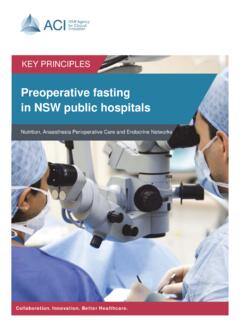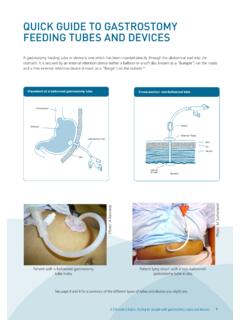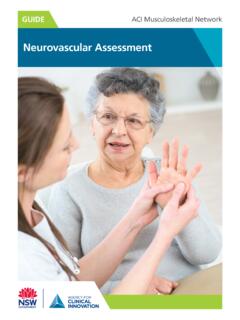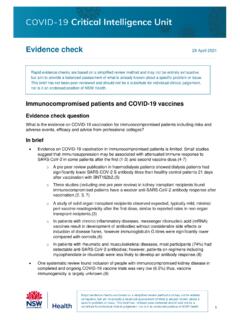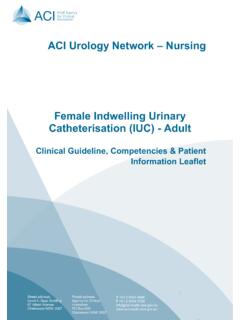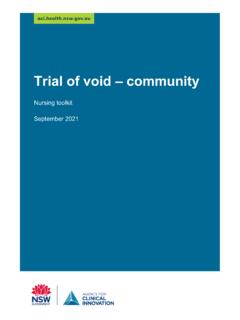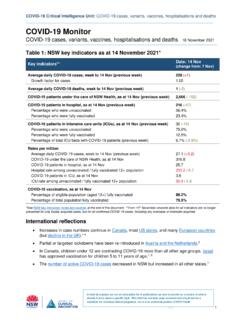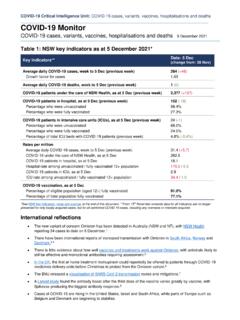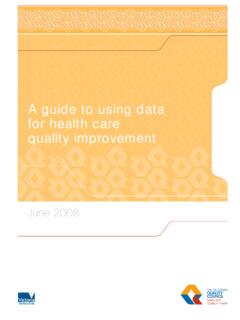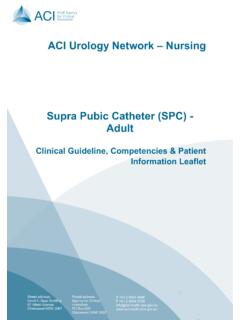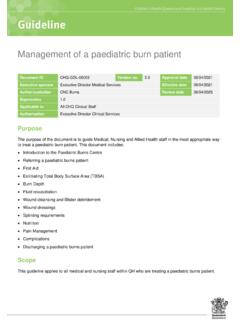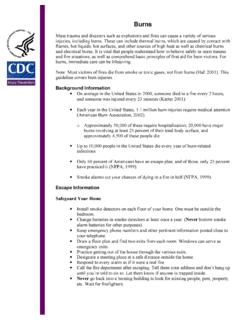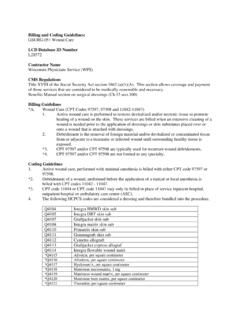Transcription of Burn Patient Management - Agency for Clinical Innovation
1 4th EditionBurn Patient ManagementStatewide burn Injury Service Clinical GUIDELINESACI Statewide burn Injury Service Clinical Guidelines: burn Patient Management Agency for Clinical Innovation67 Albert Avenue Chatswood NSW 2067PO Box 699 Chatswood NSW 2057 T +61 2 9464 4666 | F +61 2 9464 4728 E | (ACI) 180009, ISBN 978-1-76000-786-7 (print). 978-1-76000-785-0 (online) Produced by: NSW Statewide burn Injury ServiceFurther copies of this publication can be obtained from the Agency for Clinical Innovation website at : Content within this publication was accurate at the time of publication. This work is copyright. It may be reproduced in whole or part for study or training purposes subject to the inclusion of an acknowledgment of the source. It may not be reproduced for commercial usage or sale. Reproduction for purposes other than those indicated above, requires written permission from the Agency for Clinical Innovation . Version: Amended design and revised blister guideDate Amended: 29/04/2019 Trim: ACI/D18/2489 ACI_0127 [04 /19] Agency for Clinical Innovation 2019 The Agency for Clinical Innovation (ACI) works with clinicians, consumers and managers to design and promote better healthcare for NSW.
2 It does this by: service redesign and evaluation applying redesign methodology to assist healthcare providers and consumers to review and improve the quality, effectiveness and efficiency of services specialist advice on healthcare Innovation advising on the development, evaluation and adoption of healthcare innovations from optimal use through to disinvestment initiatives including guidelines and models of care developing a range of evidence-based healthcare improvement initiatives to benefit the NSW health system implementation support working with ACI Networks, consumers and healthcare providers to assist delivery of healthcare innovations into practice across metropolitan and rural NSW knowledge sharing partnering with healthcare providers to support collaboration, learning capability and knowledge sharing on healthcare Innovation and improvement continuous capability building working with healthcare providers to build capability in redesign, project Management and change Management through the Centre for Healthcare Clinical Networks, Taskforces and Institutes provide a unique forum for people to collaborate across Clinical specialties and regional and service boundaries to develop successful healthcare innovations.
3 A priority for the ACI is identifying unwarranted variation in Clinical practice and working in partnership with healthcare providers to develop mechanisms to improve Clinical practice and Patient care. AcknowledgementsThese guidelines were developed with the collaboration of the members of the Multidisciplinary Team of the ACI Statewide burn Injury Service (from Royal North Shore Hospital [RNSH], Concord Repatriation General Hospital [CRGH] and The Children s Hospital at Westmead [CHW]).ACI Statewide burn Injury Service Clinical Guidelines: burn Patient Management Page iACIA gency for Clinical InnovationAgSilverCCentigradeCHWThe Children s Hospital at WestmeadCNCC linical Nurse ConsultantCoagsCoagulation testCRGHC oncord Repatriation General HospitalECGE lectrocardiogramEDEmergency DepartmentEUCE lectrolytes Urea Creatinine FBCFull Blood Counthr(s)Hour(s)IDCIn -Dwelling CatheterIVIntravenousIMIntramuscularkgKi logramsMaxMaximumMgMilligrams mLMillilitres mmMillimetres NSWNew South WalesRNSHR oyal North Shore HospitalSBISS tatewide burn Injury ServiceTBSAT otal Body Surface AreayrsyearsAbbreviationsACI Statewide burn Injury Service Clinical Guidelines.
4 burn Patient Management Page iiContentsAcknowledgements iAbbreviations iiIntroduction 1 Management of the burn wound first aid 2 Emergency assessment and Management of severe burns 3 Assessment of burn injury: Total Body Surface Area 6 Pain 7 Initial assessment of the burn wound depth 8 burn unit admission criteria 11 burn wound Management 12 Selecting an appropriate dressing quick reference guide 16 The multidisciplinary team 24 Websites 25 Appendices 26 ACI Statewide burn Injury Service Clinical Guidelines.
5 burn Patient Management Page iiiThe following guidelines were developed by specialist staff working within the ACI Statewide burn Injury Service (SBIS) from the tertiary burn units at The Children s Hospital at Westmead (CHW), Royal North Shore Hospital (RNSH) and Concord Repatriation General Hospital (CRGH). The guidelines are designed for use by staff working in these burn units, and clinicians working in other areas and facilities, to guide practice, not to replace Clinical judgement. burn units provide specialist, multidisciplinary care in the Management of burn injuries, which is not readily available in outlying areas. They re-evaluate and adjust treatments according to current research and recommendations. burn care involves high expense for wound Management materials, staffing, equipment and long term scar Management products. There are also commonly long-term issues arising from the initial trauma, resultant scars and the ongoing effects these have on the Patient and their family.
6 It is acknowledged that primary care or follow up Management of burn injuries may occur outside of specialist units, particularly for patients with a minor burn . These guidelines are designed as a practical guide to complement relevant Clinical knowledge and the care and Management techniques required for effective Patient Management . Clinicians working outside a specialist burn unit are encouraged to liaise closely with their colleagues within the specialist units for advice and support in burn Patient Management . Due to the dynamic nature of burn wounds and the large and changing number of available wound Management products, it is not possible to state emphatically which product is superior for each wound , however suggestions of possible dressings for different wound types are included in this document, along with application For the purpose of this guideline a child is defined as less than 16 years of Statewide burn Injury Service Clinical Guidelines: burn Patient Management Page 1 Management of the burn wound first aidAim Stop the burning process.
7 Cool the burn the burn process Remove Patient from the source of injury. If on fire STOP, DROP, COVER face and ROLL. Remove hot, scalding or charred clothing. Avoid self-harm during above the burn wound Cool the burn with cool running tap water for 20 minutes. If it is a chemical burn continue cooling for 1 2 hours. Ideal water temperature for cooling is 15 C, range 8 C to 25 C. Cooling is effective up to 3 hrs after injury. Keep the remaining areas dry and warm to avoid hypothermia. If Patient s body temperature falls below 35 C stop Ice should not be used as it causes vasoconstriction and hypothermia. Ice can also cause burning when placed directly against the skin. Duration of running water should be 20 minutes unless other factors prevent this ( large burn causing rapid heat loss, hypothermia, and multiple traumas). Wet towels, pads or hydrogel tea tree dressings ( BurnAid , Waterjel , etc.) are not efficient at cooling the burn as they do not cool the wound adequately.
8 They should not be used unless there is no water readily available, in transit to medical care. If required use two moistened towels or pads and alternate at 15 second intervals. Remove any jewellery or constrictive clothing as soon as medical advice Dial 000 (Triple Zero) for any burn over 10% of the body for adults, 5% of the body for children, or when there are associated trauma or concerns. Visit a local doctor if the burn is larger than the size of a 20c piece with blisters, or if there are any concerns about the cling wrap is an appropriate simple dressing for transferring patients with burn injuries to a specialist burns unit. It protects against colonisation, excess fluid and heat arrival at hospital Place the person on a clean dry sheet and keep them warm. Keep the burn covered with plastic cling wrap and a clean sheet when not being assessed. Elevate burnt limbs, and head of bed for burns to head and neck. Small burns may require continuous application of water to reduce pain.
9 For chemical burns identify the chemical involved. If the chemical is a powder first brush off excess, then irrigate. Chemical burns require copious amounts of water for prolonged periods (at least 60 minutes). A shower is preferable as the chemicals are washed away from the body. Eye burns require an eye stream (saline) or an IV bag of saline attached to a giving set and placed over the open eye to flush it adequately until ph is burning process is stopped and the burn wound is further information see NSW Statewide burn Injury Service Transfer Guidelines Transfer Statewide burn Injury Service Clinical Guidelines: burn Patient Management Page 2 Emergency assessment and Management of severe burnsAimImmediate life threatening conditions are identified and emergency Management managementPrimary survey A. Airway maintenance with cervical spine control It is important to maintain a patent airway. Inspect the airway for foreign material or oedema. If the Patient is unable to respond to verbal commands open the airway with a chin lift and jaw thrust.
10 Insert a Guedel Airway if airway patency is compromised. Think about early intubation. Stabilise the neck for suspected cervical spine injury. Keep movement of the cervical spine to a minimum and never hyper-flex or hyperextend the head or Breathing and ventilation Administer 100% oxygen. Expose the chest and ensure that chest expansion is adequate and bilaterally equal. Palpate for crepitus and abnormalities such as rib fractures. Auscultate for breath sounds bilaterally. Ventilate via a bag and mask or intubate the Patient if necessary. Monitor respiratory rate beware if rate is <10 or >20 per minute. Apply pulse oximeter monitor. Beware circumferential deep dermal or full thickness chest burns is escharotomy required? Consider carbon monoxide poisoning, non-burnt skin may be cherry pink in colour in a non-breathing Patient (send blood for carboxyhaemaglobin).C. Circulation with haemorrhage control Inspect for any obvious bleeding stop with direct pressure.
